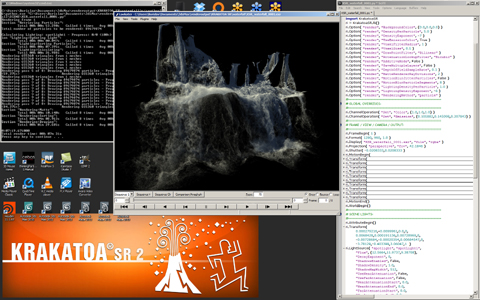What Is KRAKATOA?¶
KRAKATOA is Thinkbox Software’s production-proven Volumetric Particle Rendering, Manipulation and Management Toolkit.
It is available as a Stand-alone renderer (KRAKATOA SR), and as a plug-in for Autodesk 3ds Max (KRAKATOA MX), Autodesk Maya (KRAKATOA MY), and MAXON Cinema 4D (KRAKATOA C4D).

|

|

|

|
| KRAKATOA SR - Stand-alone Renderer | KRAKATOA MX in Autdoesk 3ds Max | KRAKATOA MY in Autodesk Maya | KRAKATOA C4D in MAXON CINEMA 4D |
KRAKATOA Hardware And Software Requirements¶
KRAKATOA is CPU-based, highly optimized for 64 bit computing, heavily multi-threaded, and can be used successfully on most hardware running Windows, Linux or macOS operating systems including laptops and render nodes without dedicated high-end graphics accelerators.
Some application-specific implementations are limited to the Operating Systems supported by the host product:
| Product | Windows | macOS | Linux |
|---|---|---|---|
| KRAKATOA SR | YES | YES | YES |
| KRAKATOA MX | YES | no | no |
| KRAKATOA MY | YES | YES | YES |
| KRAKATOA C4D | YES | YES | no |
Short KRAKATOA Features Overview¶
KRAKATOA was specifically designed to process and render millions and even billions of particles and adapts its memory footprint to the requested rendering features.
It provides a pipeline for acquiring, caching, transforming, modifying, shading and rendering vast quantities of particles at unprecedented speed to represent natural phenomena like dust, smoke, silt, ocean surface foam, plasma and even solid objects.

KRAKATOA offers both Particle and Voxel rendering modes using the same source data.
It supports volumetric and additive particle shading, as well as a mixture of the two modes.
High-quality particle self-shadowing and shadow casting from matte objects are calculated as part of the volumetric lighting calculations. KRAKATOA MX also implements OpenEXR-based Deep Opacity Maps for shadows integration with other renderers.
Texture mapping can be applied in all integrated versions (excluding KRAKATOA SR).
Per-particle Scatter, Emission, Absorption and Density data channels, as well as various Light Scattering models allow deep levels of control over the final image.
Motion Blur and Depth Of Field camera effects are naturally supported.
The unclamped High Dynamic Range output to OpenEXR files can also include various render passes for image post processing.
KRAKATOA integrates with the native particle systems of 3ds Max, Maya and CINEMA 4D, and provides data exchange capabilities for sharing particles with other 3D and simulation applications.

KRAKATOA SR offers a powerful C++ API which could be used to connect the renderer to 3D and 2D applications like SideEffects Houdini, The Foundry’s Nuke, and so on. The KRAKATOA MY integration with Autodesk Maya and the KRAKATOA C4D integration with MAXON CINEMA 4D also rely on this C++ API to ensure deep and seamless integration of the renderer into the host applications.
Both KRAKATOA MX, KRAKATOA MY, and KRAKATOA C4D include the ability to generate millions of particles using a particle partitioning method which overcomes memory and system limitations of the host 3D application. All KRAKATOA versions also implement a Particle Repopulation algorithm to turn low-resolution particle sequences into high-volume clouds with arbitrary particle counts.
KRAKATOA introduced the open, compact and flexible .PRT particle data format which is supported by many 3rd party aplications. In addition, it also supports NextLimit’s RealFlow particle BIN and RPC file formats, several industry-standard LiDAR file formats, a versatile and easy to use ASCII Comma Separated Values .CSV format which could be used to interact with any application that can read and write text files.
Click here for a more detailed overview of the KRAKATOA feature set.
KRAKATOA In Production¶

KRAKATOA has been used to generate visual effects and elements for movies like “Superman Returns”, “Journey To The Center Of The Earth 3D”, “G.I.Joe”, “Twilight:New Moon”, “Avatar”, “Harry Potter And The Deathly Hallows 2”, “Transformers 3”, both “The Avengers” movies, “Superman Man Of Steel” and many more, as well as for numerous TV series, game trailers and commercials.
Short KRAKATOA History¶
| Date | Krakatoa Milestone |
|---|---|
| 2004 | A prototype point renderer was developed at Frantic Films VFX as part of the Marc Forster movie project “Stay” with Ryan Gosling and Ewan McGregor. |
| 2005 - 2006 | KRAKATOA was originally developed as a fast stand-alone point renderer for the in-house needs of Frantic Films VFX while working on the movie “Superman Returns”. |
| July 2006 | KRAKATOA for 3ds Max was announced and first demonstrated at SIGGRAPH 2006 in Boston, MA. |
| July 2007 | KRAKATOA was released as an integrated plug-in renderer for Autodesk 3ds Max at SIGGRAPH 2007 in San Diego, CA. |
| July 2011 | KRAKATOA SR was announced at SIGGRAPH 2011 in Vancouver, BC. KRAKATOA for 3ds Max was renamed to KRAKATOA MX. |
| Feb. 2013 | KRAKATOA SR was released, together with KRAKATOA MY, an integrated plug-in renderer version for Autodesk Maya based on the KRAKATOA SR C++ API. |
| April 2014 | KRAKATOA C4D was released as an integrated plug-in renderer for MAXON CINEMA 4D at NAB 2014 in Las Vegas, NV. |
| Fall 2016 | KRAKATOA 3.0 development breaks new ground in renderer integration. Stay tuned as the story unfolds in 2017… |

